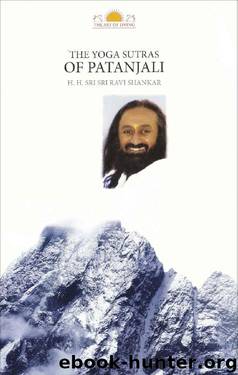The Yoga Sutras of Patanjali by Sri Sri Ravi Shankar

Author:Sri Sri Ravi Shankar [Shankar, Sri Sri Ravi]
Language: eng
Format: epub
Publisher: Art of Living Foundation
Published: 2017-07-20T20:00:00+00:00
It is the same thing with seeing. People don’t see. You can have many instances and do many experiments to prove the fact that people don’t see things as they are. We are insensitive to people. This is another thing. Because we don’t see, we don’t hear properly and are totally insensitive to people’s feelings. Samadhi is sensitivity to others’ feelings, too. When you become sensitive and this instrument here becomes sensitive, then the world and nature becomes sensitive to you. Nature listens to you.
How can this happen? What is the condition? Kshenavrutter. When all five activities [vruttis] that we have dealt with before, are subdued. Subdue these activities. Kshenavrutterbhijatasyeva manergrahetrugrahana grahyeshutatst-hatadanjanata samapathihi. The consciousness which grabs or holds, the object it holds, and the senses through which it holds, when all three are in harmony that is samadhi. Do you get this point?
One who is seeing, the mind, the Self which is seeing is in harmony. The senses are in harmony. The eyes are the instrument through which you hold seeing. Ears are the instrument through which you hold sound. So your ear, sound, and from where it is coming – whoever is speaking – all three are connected. They all become keen and crystal clear. This can happen when your mind is not going on its own trip of regret, anger, anticipation and all that. The five vruttis: proof, wrong knowledge, fantasy, sleep, and memory.
When you look at a mountain, you don’t just look at the mountain. “Oh, this is a beautiful mountain!” Immediately the mind says, “Oh, this is beautiful!” And then it doesn’t even stop there. “This is beautiful, oh, it is like Canada,” or “It is like the Himalayas.” Immediately, something is added to it. You are not seeing things as they are, but you are seeing through memory, through comparison. That is no samadhi.
There is an old story from India. It is said a king heard about a garden that a person had made with sunflowers. A beautiful sunflower garden in the middle of the desert (Rajasthan is all desert). Amidst the desert, a man had cultivated, toiled and made a beautiful sunflower field or garden. The king heard about it and everybody said, “It’s very beautiful. You should go and see it.” So he decided to go there. When he went, he saw only one flower. The man who was cultivating it had removed all the other flowers but that one. The king said, “What! I heard a lot about your garden.” He said, “Here is the flower for you to see. When there were so many, you would compare and just to make it easier for you to look at a flower, I removed everything else.” Your calculating mind will start, “Which is bigger? This is bigger, that is bigger, that is nice, this is blossoming and that is not blossoming.” Now he has no choice! There is only one flower to look at.
Graheetru grahana grahyeshu. Grahetr, that which holds. What holds? The mind, the soul, holds the sight, the sound, the taste and the memory.
Download
This site does not store any files on its server. We only index and link to content provided by other sites. Please contact the content providers to delete copyright contents if any and email us, we'll remove relevant links or contents immediately.
Periodization Training for Sports by Tudor Bompa(8170)
Bodyweight Strength Training by Jay Cardiello(7841)
Born to Run: by Christopher McDougall(7065)
Inner Engineering: A Yogi's Guide to Joy by Sadhguru(6725)
Asking the Right Questions: A Guide to Critical Thinking by M. Neil Browne & Stuart M. Keeley(5635)
The Fat Loss Plan by Joe Wicks(4847)
Bodyweight Strength Training Anatomy by Bret Contreras(4613)
Yoga Anatomy by Kaminoff Leslie(4306)
Dynamic Alignment Through Imagery by Eric Franklin(4118)
Science and Development of Muscle Hypertrophy by Brad Schoenfeld(4089)
ACSM's Complete Guide to Fitness & Health by ACSM(3989)
Exercise Technique Manual for Resistance Training by National Strength & Conditioning Association(3956)
The Four-Pack Revolution by Chael Sonnen & Ryan Parsons(3932)
Bodyweight Strength Training: 12 Weeks to Build Muscle and Burn Fat by Jay Cardiello(3915)
The Ultimate Bodybuilding Cookbook by Kendall Lou Schmidt(3886)
Yoga Anatomy by Leslie Kaminoff & Amy Matthews(3863)
American Kingpin by Nick Bilton(3757)
Nutrition for Sport, Exercise, and Health by Spano Marie & Kruskall Laura & Thomas D. Travis(3715)
Yoga Therapy by Mark Stephens(3703)
